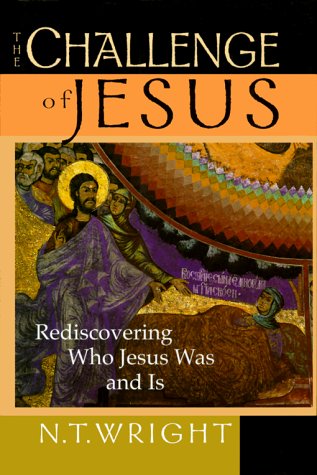One of the best books about the Christian faith, and the role of Jesus, his mission and  resurrection, is The Challenge of Jesus by N. T. Wright. (IVP) It is not as tediously academic as his massive serious works, but it is more meaty than his lovely sermon collections or more basic books. We recommend all of his books, of course, but this is great. InterVarsity Press took a few excerpts of it and published them as a little paperback called The Challenge of Easter.
resurrection, is The Challenge of Jesus by N. T. Wright. (IVP) It is not as tediously academic as his massive serious works, but it is more meaty than his lovely sermon collections or more basic books. We recommend all of his books, of course, but this is great. InterVarsity Press took a few excerpts of it and published them as a little paperback called The Challenge of Easter.
Wright is quite clear: “What Jesus did was unique, climatic, and decisive.” A good set of sturdy words to ponder this Easter day.
And then, he continues, with the “so what” question:
[this foundation]…does provide the pattern, the shape, the basis for a building to be constructed. Our task is to implement Jesus’ unique achievement. We are like the musicians called to play and sing the unique and once-only-written musical score. We don’t have to write it again, but we have to play it. Or, in the image Paul uses in 1 Corinthians 3, we are now in a position of young architects discovering a wonderful foundation already laid by a master architect and having to work out what sort of building was intended…
Just as in Genesis, so now in the new Genesis, the new creation, God breathes into human nostrils his own breath, and we become living stewards, looking after the garden, shaping God’s world as his obedient image-bearers. Paul, indeed, uses the image of the gardener alongside that of the builder in 1 Corinthian 3. We are to implement Jesus’ unique achievement.
This perspective should open the Gospels for us in a whole new way. Everything that we read there tells us something about the foundation upon which we are called to build. Everything, therefore, gives us hints about what sort of building it is to be. Jesus was to Israel, so the church is to be for the world.
But, you say, the people we minister to, the people we work with in the laboratory or the fine arts department, the people who serve us in the grocery store or who work in the power station, are not first-century Jews. How can we summon them as Jesus summoned his contemporaries? How can we challenge them in the same way? What is the equivalent? What is the key to help us to translate Jesus’ message into our own?
The key is that humans are made in the image of God. That is the equivalent, on the wider canvas, of Israel’s unique position and vocation. And bearing God’s image is not just a fact, it is a vocation. It means being called to reflect into the world the creative and redemptive love of God. It means being made for relationship, for stewardship, for worship—or, to put it more vividly, for sex, gardening and God.
Human beings know in their bones that they are made for each other, made to look after and shape this world, made to worship the one in whose image they are made. But like Israel with her vocation, we get it wrong. We worship other gods and start to reflect their likeness instead. We distort our vocation to stewardship into the will to power, treating God’s world as either a gold mine or an ashtray. And we distort our calling to beautiful, healing, creative many-sided human relationships into exploitation and abuse….
…Our task, as image-bearing, God-loving, Christ-shaped, Spirit-filled Christians following Christ and shaping our world, is to announce redemption to the world that has discovered its fallenness, to announce healing to the world that has discovered its brokenness, to proclaim love and trust to the world that knows only exploitation, fear, and suspicion.
Humans were made to reflect God’s creative stewardship into the world. Israel was made to bring God’s rescuing love to bear upon the world. Jesus came as the true Israel, the world’s true light, and as the true image of the invisible God. He was the true Jew, the true human. He has laid the foundation, and we must build upon it. We are to be the bearers both of his redeeming love and of his creative stewardship: to celebrate it, to model it, to proclaim it, to dance it.
Hearts & Minds 234 East Main Street Dallastown, PA 17313 717.246.3333
